Pro-resolving lipid mediator ameliorates obesity induced osteoarthritis by regulating synovial macrophage polarisation
- PMID: 30674985
- PMCID: PMC6344566
- DOI: 10.1038/s41598-018-36909-9
Pro-resolving lipid mediator ameliorates obesity induced osteoarthritis by regulating synovial macrophage polarisation
Abstract
Non-resolved persistent macrophage-mediated synovial inflammation is considered as one of the main drivers of both the establishment and progression of obesity-associated osteoarthritis (OA). Herein, we used clodronate-loaded liposomes (CL) to locally deplete macrophages in the synovial joints to examine the role of macrophages in the progression of obesity-induced OA. Furthermore, resolvin D1 (RvD1), a unique family of pro-resolving lipid mediator derived from the omega-3 polyunsaturated fatty acid, have shown marked potency in changing the pro-inflammatory behaviour of the macrophages. We sought to determine whether RvD1 administration ameliorates obesity-induced OA by resolving macrophage-mediated synovitis. Therapeutic properties of RvD1 and macrophage depletion (CL) were tested for its ability to slow post-traumatic OA (PTOA) in obese mice models. PTOA was induced in C57Bl/6 mice fed with high-fat diet (HFD) by surgically destabilising the meniscus. Firstly, CL treatment showed beneficial effects in reducing synovitis and cartilage destruction in obese mice with PTOA. In vitro treatment with RvD1 decreased the levels of pro-inflammatory markers in CD14+ human macrophages. Furthermore, intra-articular treatment with RvD1 diminishes the progression of OA in the knee joint from mice as follows: (a) decreases macrophages infiltration in synovium, (b) reduces the number of pro-inflammatory macrophages in synovium and (c) improves the severity of synovitis and cartilage degradation. Thus, our results provide new evidence for the potential targeting of macrophages in the treatment of obesity-induced OA.
Conflict of interest statement
The authors declare no competing interests.
Figures

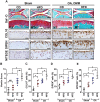
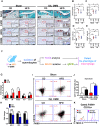
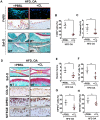
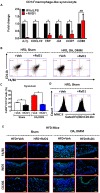
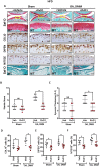
Similar articles
-
Obesity-associated metabolic syndrome spontaneously induces infiltration of pro-inflammatory macrophage in synovium and promotes osteoarthritis.PLoS One. 2017 Aug 31;12(8):e0183693. doi: 10.1371/journal.pone.0183693. eCollection 2017. PLoS One. 2017. PMID: 28859108 Free PMC article.
-
Sustained release resolvin D1 liposomes are effective in the treatment of osteoarthritis in obese mice.J Biomed Mater Res A. 2023 Jun;111(6):765-777. doi: 10.1002/jbm.a.37512. Epub 2023 Feb 11. J Biomed Mater Res A. 2023. PMID: 36773024
-
Down-regulated GAS6 impairs synovial macrophage efferocytosis and promotes obesity-associated osteoarthritis.Elife. 2023 May 5;12:e83069. doi: 10.7554/eLife.83069. Elife. 2023. PMID: 37144868 Free PMC article.
-
Macrophages regulate the progression of osteoarthritis.Osteoarthritis Cartilage. 2020 May;28(5):555-561. doi: 10.1016/j.joca.2020.01.007. Epub 2020 Jan 23. Osteoarthritis Cartilage. 2020. PMID: 31982565 Review.
-
Immune Contributions to Osteoarthritis.Curr Osteoporos Rep. 2017 Dec;15(6):593-600. doi: 10.1007/s11914-017-0411-y. Curr Osteoporos Rep. 2017. PMID: 29098574 Review.
Cited by
-
The Rationale for the Intra-Articular Administration of Clodronate in Osteoarthritis.Int J Mol Sci. 2021 Mar 7;22(5):2693. doi: 10.3390/ijms22052693. Int J Mol Sci. 2021. PMID: 33799992 Free PMC article. Review.
-
Role of Mesenchymal Stem Cells and Their Paracrine Mediators in Macrophage Polarization: An Approach to Reduce Inflammation in Osteoarthritis.Int J Mol Sci. 2022 Oct 27;23(21):13016. doi: 10.3390/ijms232113016. Int J Mol Sci. 2022. PMID: 36361805 Free PMC article. Review.
-
The role of macrophages in osteoarthritis and cartilage repair.Osteoarthritis Cartilage. 2020 May;28(5):544-554. doi: 10.1016/j.joca.2019.12.007. Epub 2020 Jan 8. Osteoarthritis Cartilage. 2020. PMID: 31926267 Free PMC article. Review.
-
Inhibition of Leukotriene A4 Hydrolase Suppressed Cartilage Degradation and Synovial Inflammation in a Mouse Model of Experimental Osteoarthritis.Cartilage. 2024 Jun;15(2):184-194. doi: 10.1177/19476035231169940. Epub 2023 Apr 21. Cartilage. 2024. PMID: 37086004 Free PMC article.
-
Targeting the Inflammatory Hallmarks of Obesity-Associated Osteoarthritis: Towards Nutraceutical-Oriented Preventive and Complementary Therapeutic Strategies Based on n-3 Polyunsaturated Fatty Acids.Int J Mol Sci. 2023 May 26;24(11):9340. doi: 10.3390/ijms24119340. Int J Mol Sci. 2023. PMID: 37298291 Free PMC article. Review.
References
Publication types
MeSH terms
Substances
LinkOut - more resources
Full Text Sources
Medical
Research Materials

